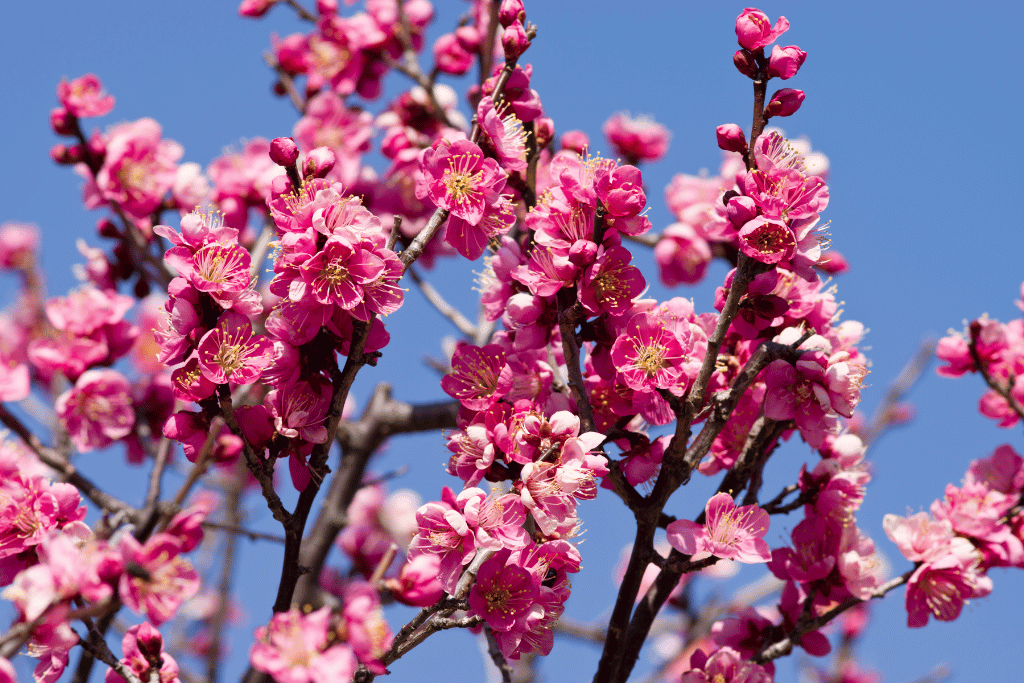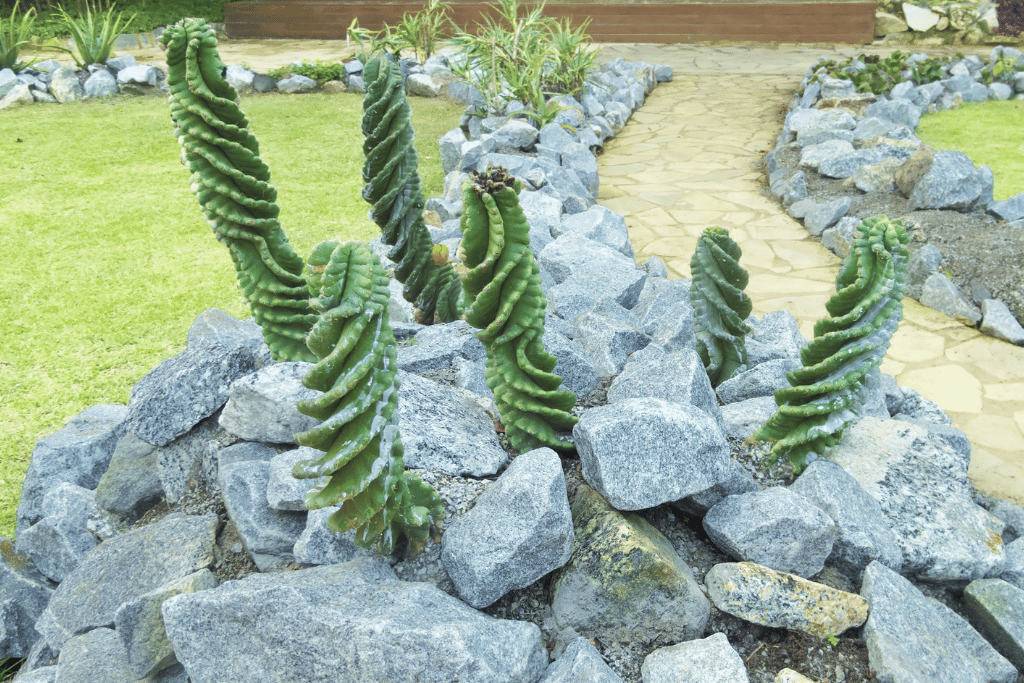
A quick glance at the spectacular spiral cactus might lead you to believe it’s some kind of sculpture or work of art. Turns out it’s a living, photosynthesizing plant with a unique, topsy-turvy shape that has made it highly sought after by cacti enthusiasts around the world.
Cereus forbesii ‘Spiralis’ is a specialty cultivar derived from columnar-type cacti. Its signature spiral shape almost resembles a large cone of soft-serve ice cream. Just don’t bite into this spiny cactus!
It’s clearly a popular plant these days, as cacti make excellent houseplants and the twisting pattern of this variety makes it exceedingly desirable. The history of this specific cultivar is not quite clear, but we do know exactly how to care for it. Read on to learn everything you need to know about the spiral cactus plant.
History
The spiral cactus plant is believed to have originated somewhere in South America. Initially, it was thought that the spiral cactus plant did not naturally occur in the wild. This may be misguided information and recent evidence indicates that the striking spires of the columnar cactus may be a natural feature after all.
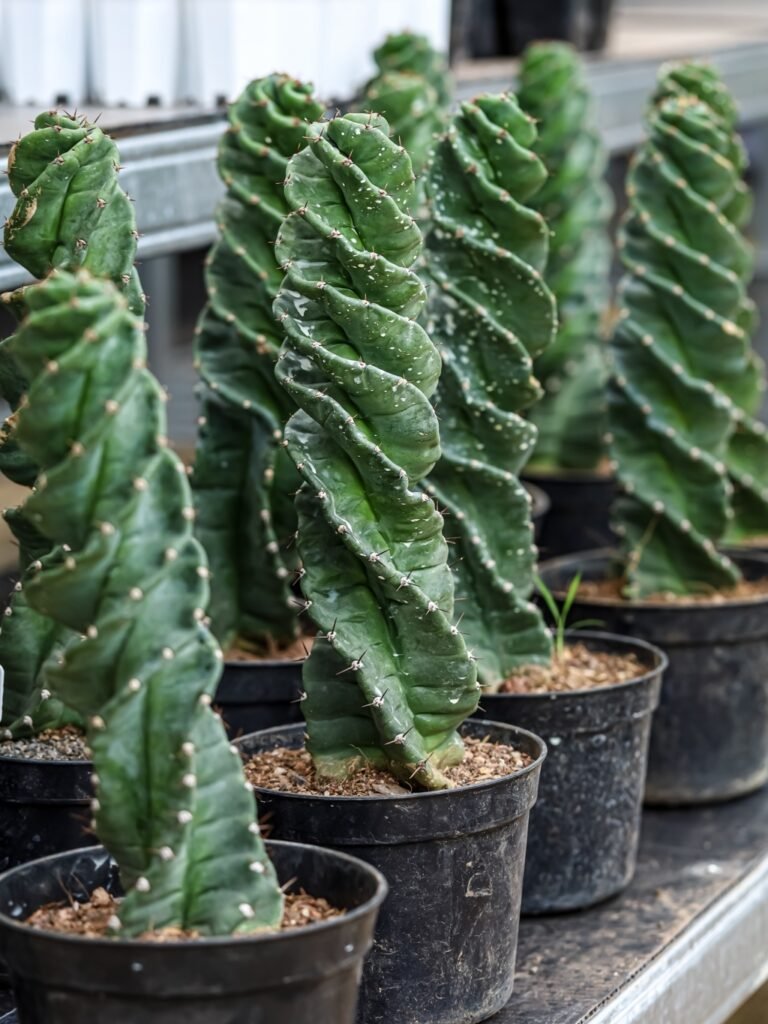
Some reports claim it was first exported from Peru to Europe, while others say the cactus originated in Brazil or Argentina. Wherever its true native home is may never be known exactly, but we do know that the specialty cactus was propagated via cuttings in the 1980s and thus began its journey to celebrity status in the world of succulents and cacti.
These days the mystique surrounding this intriguing cactus leads to its popularity and high demand.
Distinct Features
The spiral cactus plant, as its name suggests, has an unmistakable corkscrew appearance.
Growth Habit
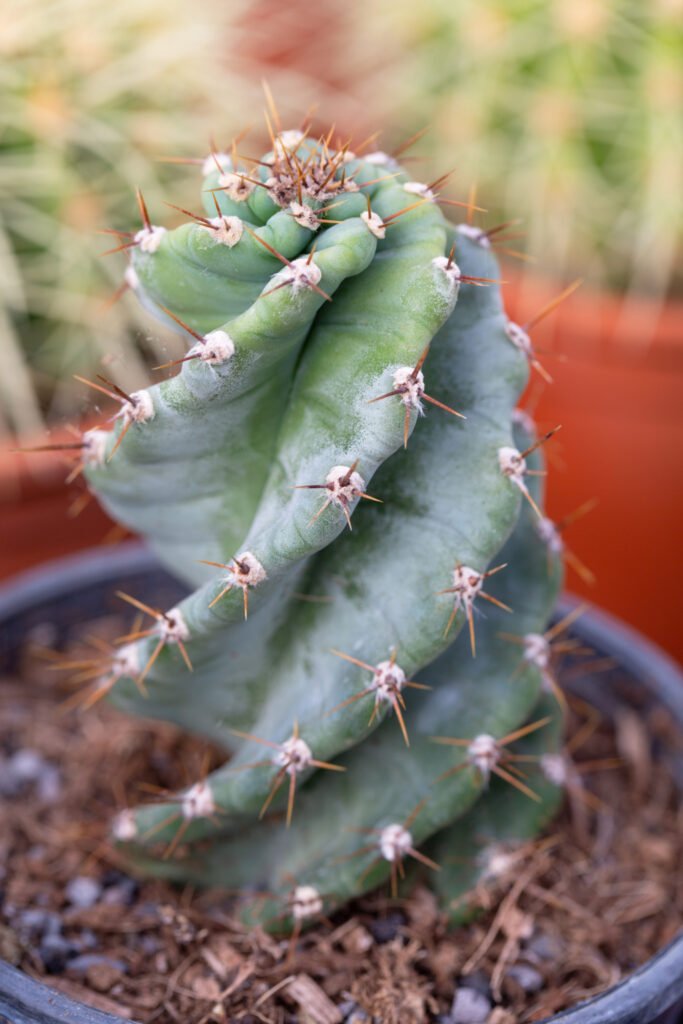
Cereus forbesii ‘Spiralis’ is a specialty columnar cactus cultivar. It grows faster and taller than most other cactus varieties. It will first grow tall and upright, eventually branching out to resemble the shape of a candelabra.
Young spiralis plants start small and may lack their signature spire shape at first. When it reaches a couple of inches tall, it inevitably starts twisting and turning. A spiral cactus plant can achieve a girth of 4-5 inches and ultimately reach a towering height of 13 feet!
Another fantastic feature of Cereus forbesii is the attractive dark purple buds and gorgeous pink and white flowers that bloom in the summer. Pollinated flowers will bear purple, non-toxic fruits.
Conditions
Cereus forbesii ‘Spiralis’ enjoys conditions similar to most cacti. Consider its native environment: Hot, sunny and dry. Replicate these conditions and your cactus will thrive.
Listed below are the specific details about creating the perfect habitat for your spiral cactus.
Soil
The medium you use for planting your spiral cactus should drain exceptionally well. Retaining too much moisture could spell disaster for the roots of the cactus. A standard succulent or cactus potting mix should work great.
An extra scoop of perlite, coarse sand, pumice or lava rock added to the mix will further improve the drainage capacity of the growing medium. The most important factor is that water drains effectively and the medium dries out quickly after watering.
If you’re going to make your own potting mix, consider this ratio.
- ⅓ Standard soil, loam or compost
- ⅓ Grit or drainage (Perlite, vermiculite, pumice, lava rock, fine pebbles)
- ⅓ Horticultural sand
This mix is sure to efficiently wick away moisture after watering.
Make sure to use a pot that is just big enough to contain the roots with a little room to grow. It should have plenty of drainage holes.
Light
True to its nature, spiral cacti prefer full sun. But there are a few special requirements to take into consideration.
Young plants that are just getting established tend to do better in shade or indirect light until they grow to maturity and become sturdier. Treat your young spiral cactus like you’re hardening off indoor vegetables in preparation for the garden. Slowly increase the amount of direct sun it receives on a daily basis until it accepts full sun all day.
Outdoors or in a greenhouse can be a great place for your spiral cactus to access full sun if the climate is right.
If growing indoors they’ll still prefer full sun, but beware they don’t get scorched by the midday sun of summer. The sunshine coming through the window can intensify the rays and scorch the cactus. This should only be an issue during the hottest days of the year and a shade or curtain can help filter the strength of the direct sun.
Otherwise, you cactus will live happily year-round in a south or west-facing window basking in the sunshine.
If you don’t have access to sunny windows in your home, consider setting up some LED grow lights to make sure your cactus gets enough bright light. Grow light can be especially helpful in the winter when the days are short and bright sunlight is hard to come by.
Temperature and Humidity
The ideal temperature range for spiral cacti is 60-80 degrees. Don’t let your cactus get exposed to temps under 50 degrees. It may stunt growth or cause deformities. Cacti won’t tolerate frosts, so always move plants indoors well before cold weather threatens.
Excessive heat can be just as damaging. Keep temperatures below 85 degrees to prevent scarring and yellowing of your cactus’ skin. During the hot summer months crack some windows or use a fan to make sure your cactus is exposed to fresh, circulating air.
Make sure you keep your cactus away from any heating or cooling units and safe from drafty windows or doors in the winter. Drastic swings in temperature can disturb the equilibrium of your spiral cactus, which relies on a steady, warm temperature.
Dry to medium humidity works well for spiral cacti. High moisture content in the air is less than ideal.
Care and Maintenance
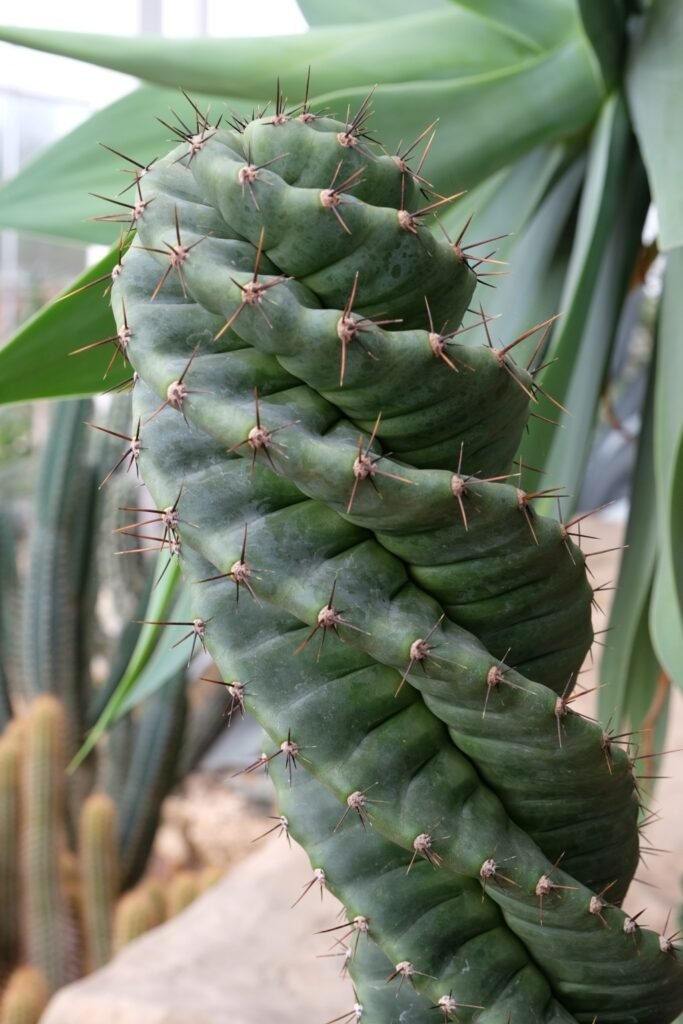
As far as houseplants go, a spiral cactus plant may be one of the easiest to care for. That doesn’t mean you can completely ignore it though. Even the toughest individuals appreciate some admiration and care from time to time.
Follow the advice below to meticulously maintain your spiral cactus.
Water
As we know, cacti are rugged desert plants and require little water.
In the growing months of spring and summer give your cactus a thorough watering once the soil has dried out. Starting at the end of summer you can begin to reduce the amount of water you give.
During the winter months your spiral cactus’ medium should be kept dry. Very little to no water will be needed as the cactus goes dormant during the short days and cold months. If your cactus looks a bit withered or shriveled give it a light watering. This should be plenty to hold it over until spring.
Never let your spiral cactus sit in a tray with standing water, always dump excess water.
Fertilizer
Choose a cactus and succulent-specific fertilizer to feed your spiralis once or twice per month during the spring and summer. Don’t feed at all in the fall and winter. Other standard fertilizers for tomatoes or vegetables work as well, just be sure to dilute them to a quarter strength and feed them less often.
Although spiral cactus is a fast grower that fruits and flowers, try not to be heavy-handed while fertilizing. Cacti are used to getting by with little nutrients and a heavy dose of fertilizer could burn, shock or kill your cactus. Less is more when it comes to feeding cacti. Only feed every third or fourth watering.
Propagation
It is possible to propagate a spiral cactus plant by taking cuttings or with seeds. Stem cuttings will be the easier, more efficient way. Seed starting is a fun, rewarding project for those with plenty of patience. Saving and planting seeds will result in unique plants that display one-of-a-kind features whereas stem cuttings will be exact clones of the mother plant.
Cuttings should be taken from a fully mature plant in the spring or summer. The columnal cactus spiralis will grow tall and eventually branch out as it gets older. The appendages it sends out make the perfect cuttings to use for propagation.
After a cutting is taken, it needs to be allowed a few days to callus over before being planted into a small container with a well-draining potting mix.
Seeds can be collected from the purple fruit that develops from fertilized flowers. They will take about 2-6 weeks to germinate and require patience. Plant seeds into a seed tray or small individual containers on the surface of a seed starting mix. The medium should retain moisture better than a typical cactus potting mix to encourage germination.
Transplanting
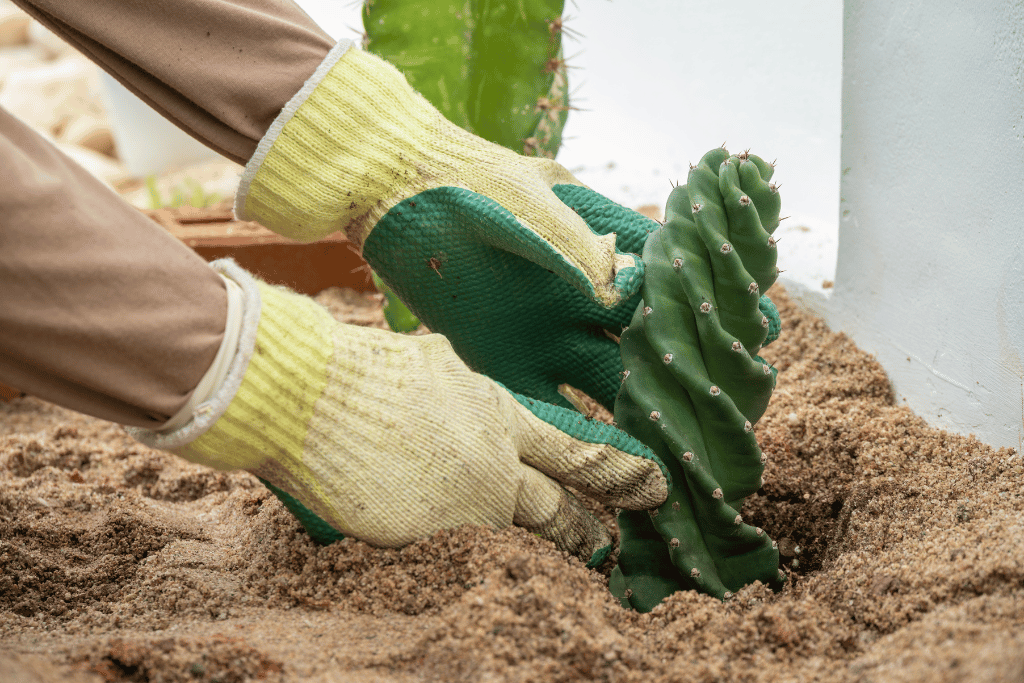
If your spiral cactus has outgrown its pot, whether it’s getting top-heavy or the roots are protruding from drainage holes, it’s time to transplant. Spring or summer is the ideal time to get this job done. It’s normal to repot spiralis once a year, and its roots grow quickly when provided more space.
So find a new pot that offers good drainage and is about twice the size of the original. Fill the pot about halfway with a well-draining cactus potting mix and set the plant in. Fill it the rest of the way, lightly tamping the soil until the cactus is firmly in place. Don’t water for about a week after transplanting. This will minimize shock and allow the roots to settle in and get used to their new home.
Don’t use too large of a container when repotting. Cacti would rather be a little rootbound than have too much space. Be sure to select a heavyweight pot because spiral cacti get tall and top-heavy, which may cause them to tip over.
Overwintering
The best way to help your spiral cactus survive the winter is to keep it in a cool dry place. You might think you should keep them warm and toasty during the cold weather but like most plants, cacti too need a winter resting period.
Let the soil dry out completely and only water if the plant starts to look sad and wrinkly.
Make sure it gets plenty of sun during the winter. While cacti prefer cool winter temperatures, they’re still accustomed to getting plenty of sunshine during this season. If your spiral cactus is tucked away from direct light during the winter, it could lead to etiolation.
Where to Find
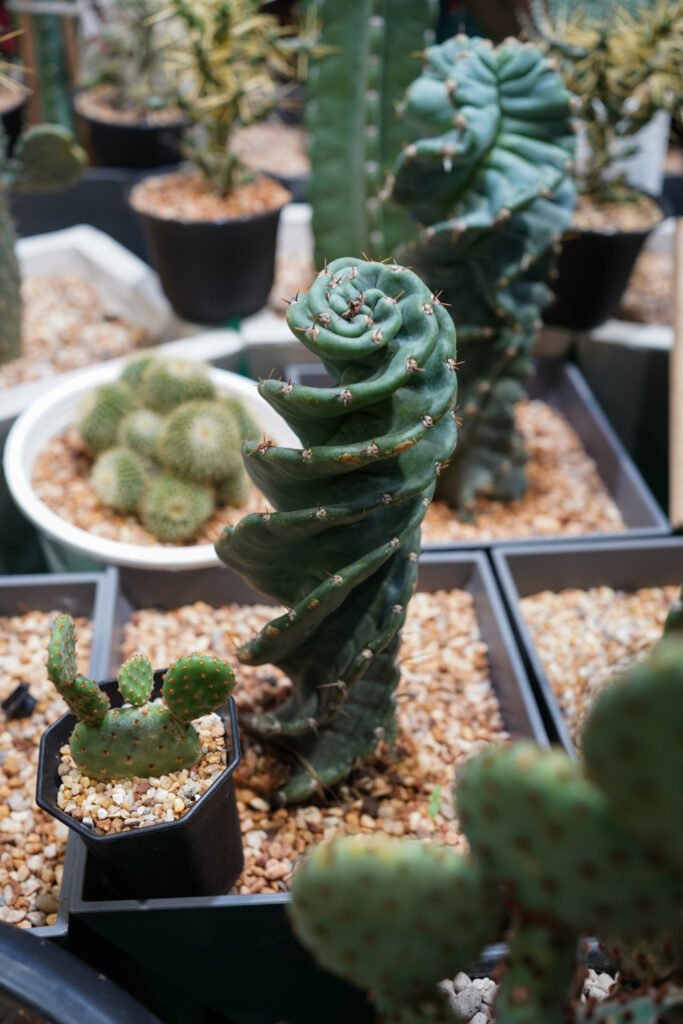
There are plenty of online sellers with live, established spiral cactus plants available. However, they cost a pretty penny and you have to wonder how well this tall, skinny plant would hold up during the shipping process. Maybe investing in a small, young plant would be the best way to risk the smallest investment and get the best shipping results.
Seeds seem to be difficult to find online as well. If you wanted to start a spiral cactus from seed, saving your own might be the best option.
Check local nurseries that specialize in succulents and cacti if there are any in your area. They should have this plant in stock based on its popularity and astoundingly unique look.
Once you have your own, you’ll be able to propagate through cuttings or by saving seeds.
Top Tips
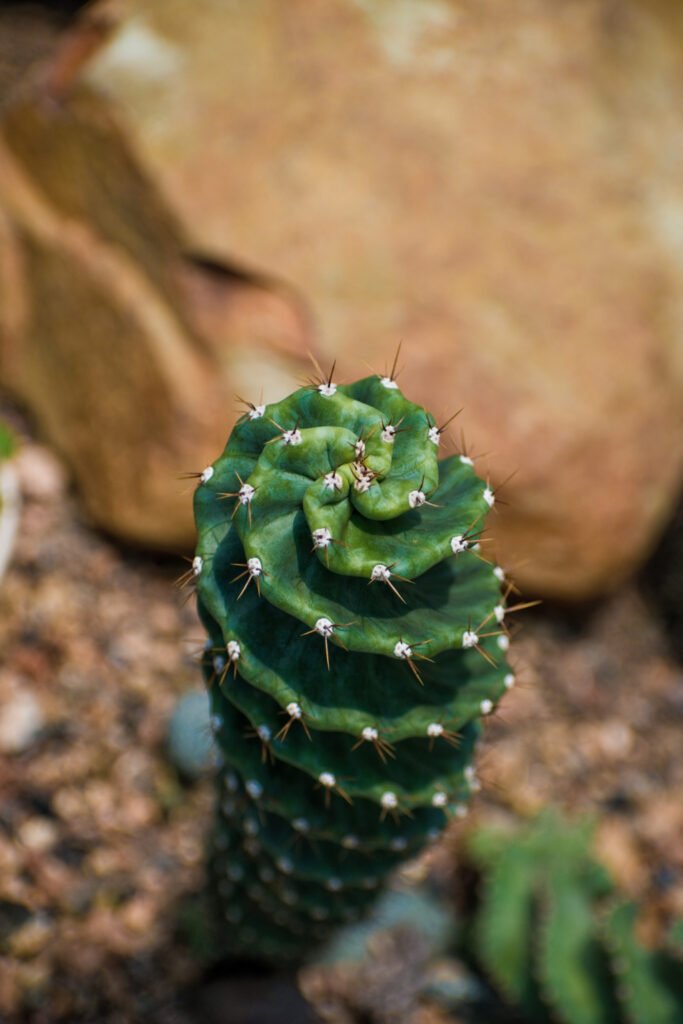
Follow these top tips to get the most out of your spiral cactus plant.
- Make sure the medium has enough grit and drains really, really well.
- Give young spiral cacti bright, indirect light and slowly acclimate them to direct sun.
- Water regularly in the spring and summer, reduce in the fall and withhold in the winter.
- Always let the medium dry out in between waterings and never let a cactus sit in pooled water.
- Mature plants need direct sun but provide protection on the hottest summer days.
- Keep your cactus warm and well-ventilated during the growing season and cool and well-lit while it’s dormant in the winter.
- Avoid temperature fluctuations, blowing heat and drafts.
- Handle with caution! The spines can cause real injuries, so keep your spiral cactus out of the reach of children and pets.
- Repot a spiral cactus plant once a year or at least every other year.
- To promote flowering, overwinter properly, feed with a phosphorus-rich fertilizer and keep the cactus in an appropriately sized container.
A Curvy Conclusion
If you’re a cactus lover and lucky enough to come across this spiraled sensation, jump at the chance to pick it up.
Spiral cactus plant is easy to maintain, grows to an amazing size, looks tremendous and will certainly be the envy of all your gardener friends!



